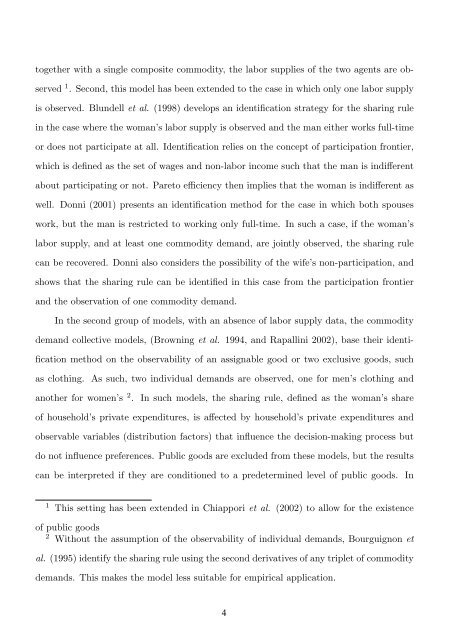THE SPANISH SHARING RULE* Bernarda Zamora - Ivie
Create successful ePaper yourself
Turn your PDF publications into a flip-book with our unique Google optimized e-Paper software.
together with a single composite commodity, the labor supplies of the two agents are observed<br />
1 . Second, this model has been extended to the case in which only one labor supply<br />
is observed. Blundell et al. (1998) develops an identification strategy for the sharing rule<br />
in the case where the woman’s labor supply is observed and the man either works full-time<br />
or does not participate at all. Identification relies on the concept of participation frontier,<br />
which is defined as the set of wages and non-labor income such that the man is indifferent<br />
about participating or not. Pareto efficiency then implies that the woman is indifferent as<br />
well. Donni (2001) presents an identification method for the case in which both spouses<br />
work, but the man is restricted to working only full-time. In such a case, if the woman’s<br />
labor supply, and at least one commodity demand, are jointly observed, the sharing rule<br />
can be recovered. Donni also considers the possibility of the wife’s non-participation, and<br />
shows that the sharing rule can be identified in this case from the participation frontier<br />
and the observation of one commodity demand.<br />
In the second group of models, with an absence of labor supply data, the commodity<br />
demand collective models, (Browning et al. 1994, and Rapallini 2002), base their identification<br />
method on the observability of an assignable good or two exclusive goods, such<br />
as clothing. As such, two individual demands are observed, one for men’s clothing and<br />
another for women’s 2 . In such models, the sharing rule, defined as the woman’s share<br />
of household’s private expenditures, is affected by household’s private expenditures and<br />
observable variables (distribution factors) that influence the decision-making process but<br />
do not influence preferences. Public goods are excluded from these models, but the results<br />
can be interpreted if they are conditioned to a predetermined level of public goods. In<br />
1 This setting has been extended in Chiappori et al. (2002) to allow for the existence<br />
of public goods<br />
2 Without the assumption of the observability of individual demands, Bourguignon et<br />
al. (1995) identify the sharing rule using the second derivatives of any triplet of commodity<br />
demands. This makes the model less suitable for empirical application.

















